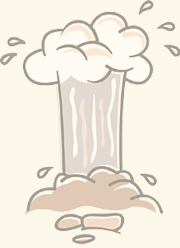 Geothermal Links
Geothermal Links
Geo-Heat Center
The Geo-Heat Center in Klamath Falls, Oregon, transfers technological information about geothermal energy to consultants, developers, potential users, and the general public. Information developed through firsthand experience with hundreds of projects and through extensive research is provided to individuals, organizations or companies involved in geothermal development.
Geothermal Education Office
The Geothermal Education Office aims to promote public understanding about geothermal resources and its importance in providing clean sustainable energy while protecting the environment. GEO produces and distributes educational materials about geothermal energy to schools, energy/environmental educators, libraries, industry, and the public. Material for sale includes:
- Curriculum: "Geothermal Energy" for grades 4-8
- Video: "Geothermal Energy: A Down to Earth Adventure" for grades 3-5
- Video: "Geothermal Energy: A Renewable Option" for grades 6-12 and general audiences (accompanying classroom activities now available; also available in Spanish and Japanese)
- CD-ROM: "The Theory of Plate Tectonics" for grades 7-12
- Slide Set: "Introduction to Geothermal Energy" for general audience
Geothermal Fact Sheet: Montana
Produced by DOE's Geothermal Technologies Program, this fact sheet provides a useful overview of geothermal's use and potential in Montana.
Geothermal Technologies Program
The Department of Energy's geothermal research and development program is to work in partnership with U.S. industry to establish geothermal energy as a sustainable, environmentally sound, economically competitive contributor to the U.S. and world energy supply. You can download a 22-page "Strategic Plan for the Geothermal Energy Program" at the Geothermal Energy Program website. The plan identifies five strategic areas of interest linked to both DOE's Strategic Plan and DOE's Comprehensive National Energy Strategy: Domestic Electric Power; Direct Use Applications and Geothermal Heat Pumps; International Geothermal Development; Science and Technology; and Future Resources.
Geothermal Resources Council (GRC)
With the experience and dedication of its diverse membership bolstering a 25-year track record, the Geothermal Resources Council (GRC) has built a reputation as one of the world's premier geothermal associations. The Council serves as a focal point for continuing professional development for its members through its many outreach, information transfer and education services.
INEEL State Geothermal Resource Maps
The Idaho National Laboratory (INL) produced geothermal resource maps of 13 western states, including Montana, for the Department of Energy.
Montana Geothermal Energy Sites
The State of Montana has more than 50 geothermal areas and at least 15 high-temperature sites. High-temperature areas in western Montana are located near Helena, Bozeman, Ennis, Butte, Boulder and White Sulphur Springs. There are seven locations with surface temperatures above 149° F, plus 20 locations with temperatures above 110° F. The estimated deep-reservoir temperatures for some Montana sites are over 350° F. See this website for details about these geothermal energy sites.
National Geothermal Student Competition
The U.S. Department of Energy (DOE) today announced the launch of its inaugural National Geothermal Student Competition. DOE, through its Geothermal Technologies Program (GTP), will provide up to $100,000 to fund as many as 10 collegiate teams that will participate in this competition. In this intercollegiate competitio--the first ever to address geothermal education--student teams will be challenged to advance their understanding of geothermal energy’s potential as a significant contributor to our nation’s energy portfolio. Geothermal technology allows for consistently produced energy by tapping into the heat of the earth and emits minimal greenhouse gases. Expanding the use of geothermal resources as a domestic energy source will play an important role in increasing America’s energy independence.
Renewable Resource Data Center (RReDC)
The Renewable Resource Data Center (RReDC) provides information on several types of renewable energy resources in the United States, in the form of publications, data, and maps. An extensive dictionary of renewable energy related terms is also provided. The News section announces new products on the RReDC, which is supported by the U. S. Department of Energy's Resource Assessment Program and managed by the Photovoltaics Technology Division of the Office of Energy Efficiency and Renewable Energy.
Residential Geothermal Systems Credit
A resident individual taxpayer of Montana who installs a geothermal heating or cooling system in their principal dwelling can claim a tax credit based on the installation costs of the system, not to exceed $1,500. For more information, contact the Montana Dept. of Environmental Quality at (406) 841-5243 .
U.S. Geothermal Power Production and Development Update
This January 2010 report from the Geothermal Energy Association (GEA) provides an update of the status of geothermal energy capacity in the U.S. According to the report, thermal energy capacity expanded 6% in the United States in 2009, due to six new geothermal plants that came online, adding 176.68 megawatts (MW). While none of the projects are in Montana, they are in western states: three in Nevada, and one in California, Oregon, and Utah. The total online capacity in the U.S. reached 3,152.72 MW as of August 2009, says GEA. Additionally, GEA has identified 6442.9 MW of new U.S. geothermal power plant capacity under development, though some of those may not go forward.


